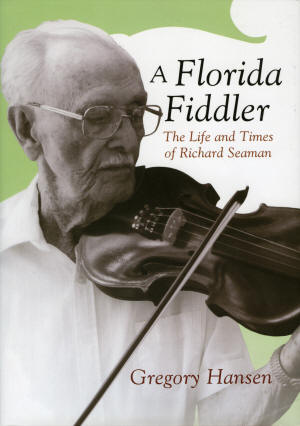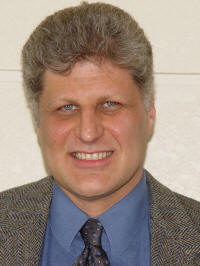University
Communications
Office
Arkansas State University
Jonesboro,
Arkansas
Staff
Markham Howe
Sara McNeil
Gina Bowman
(870) 972-3056
fax (870) 972-3693
More information:
NewsPage
Links to News Releases
& Announcements
Campus Calendar
Public activities at ASU
About
ASU
Overview, history
and more |
March 14 book
signing, jam session, provide prelude to Delta Blues Symposium XV's
exploration of musical connections
March 12, 2009 --
Dr.
Gregory Hansen, English and Folklore, will be signing copies of his
book, "A Florida Fiddler: The Life and Times of Richard Seaman," at That
Bookstore in Blytheville (TBIB) on Saturday, March 14, at 7 p.m. After
the signing, Rachel Reynolds, who holds the Janna Lambert Scholarship in
History, will host and perform in a fiddle jam session that is open to
any interested old-time and/or bluegrass musicians. According to TBIB's
Web site, Hansen's "A Florida Fiddler " is more than
"a biography of a traditional fiddle
player. It is a chronicle of the collaboration between a fieldworker and
his subject. It is also an exploration of the evolution of a tradition,
a look at the methods of public-sector folklorists, and a regional
history of central and north-east Florida. Finally, it is a study of the
American tall tale in its Southern incarnation." For details, contact
That Bookstore in Blytheville,
316 W. Main, (870) 763-3333. Dr. Hansen discussed "A Florida Fiddler" on
a recent edition of KASU's "Music from the Isles," with host Mike Doyle,
director, KASU 91.9 FM.
"A Florida Fiddler: The Life and Times of Richard Seaman," at That
Bookstore in Blytheville (TBIB) on Saturday, March 14, at 7 p.m. After
the signing, Rachel Reynolds, who holds the Janna Lambert Scholarship in
History, will host and perform in a fiddle jam session that is open to
any interested old-time and/or bluegrass musicians. According to TBIB's
Web site, Hansen's "A Florida Fiddler " is more than
"a biography of a traditional fiddle
player. It is a chronicle of the collaboration between a fieldworker and
his subject. It is also an exploration of the evolution of a tradition,
a look at the methods of public-sector folklorists, and a regional
history of central and north-east Florida. Finally, it is a study of the
American tall tale in its Southern incarnation." For details, contact
That Bookstore in Blytheville,
316 W. Main, (870) 763-3333. Dr. Hansen discussed "A Florida Fiddler" on
a recent edition of KASU's "Music from the Isles," with host Mike Doyle,
director, KASU 91.9 FM.
This article, by
Dr. Gregory Hansen, associate professor of English and Folklore,
Department of English and Philosophy at Arkansas State
University-Jonesboro, originally appeared as part of the series
ASU Biology in the News,
(#197), a series of
articles about various aspects of science, including research and
opinions, which
appears every Sunday in The
Jonesboro Sun, northeast Arkansas's daily newspaper.
originally appeared as part of the series
ASU Biology in the News,
(#197), a series of
articles about various aspects of science, including research and
opinions, which
appears every Sunday in The
Jonesboro Sun, northeast Arkansas's daily newspaper.
Arkansas State University-Jonesboro’s Department of English
and Philosophy will provide the public with opportunities to explore
connections between different types of roots music and the blues in
their 15th annual
Delta Blues Symposium. This year’s theme is “Celebrating a Century
of Delta Culture,” and the event will be held at ASU’s Reng Student
Services Center/Student Union, 101 N. Caraway Road, April 2-4.
A number of distinctive musical traditions come together in the uniquely
American style of music known as bluegrass. In the 1940s, Kentuckian
Bill Monroe blended together old-time string band music, ballads, blues,
gospel, and other genres to create his own sound in his band, Bill
Monroe and the Blue Grass Boys. A rich and virtuosic fiddling style has
emerged in this music that blends together blues music with old-time
hoedowns.
Early country fiddlers were influenced from a variety of European styles
of instrumental music. They brought their musical traditions and the
fiddle to America during the Colonial era, and by the American
Revolution, social dancing to the fiddle was a popular form of
entertainment across the emerging nation. America’s southern states
became especially well known for the richness of their fiddling
tradition, and a distinct style of music emerged.
The square dance was popular in many communities, and in many southern
states, many of the fiddlers were African-Americans. Folklorists and
music historians have identified unique techniques for playing the
fiddle and distinct rhythms that show a clear influence from
African-American musicians. The influence of African-American culture
is a major contributor to the unique quality of distinctive fiddle
styles.
Old-time string band music was thriving by the early 19th
century, and it predates another important form of roots music, the
blues. Blues music emerged a century ago in African-American
communities, and it shows clear influences from earlier genres. By the
time that Monroe crystallized the bluegrass sound, the blues had become
a major form of popular music. In turn, the blues had a major influence
on bluegrass.
Monroe’s debt to
the blues is multifaceted. As a young man growing up in Rosine, Ky., he
became enamored with the blues music of Arnold Schultz, an
African-American country blues player in Monroe’s community. Bluegrass
lyrics, song structure, rhythms and instrumental techniques show a clear
influence from Schultz’s blues and other musical forms popular in the
1930s and 40s. Another influence of blues on the bluegrass sound came
from Monroe to a fiddle virtuoso named Robert “Chubby” Wise.
Wise was born in St. Augustine and raised in Lake City,
Fla. He grew up playing the fiddle in an old-time style, and his early
recordings suggest that he was influenced by Florida’s rich blues
tradition. After he replaced Howdy Forrester as an early member of
Monroe’s band, Wise became one of the most influential bluegrass
fiddlers in the world. He is credited with “putting ‘the blues’ into
bluegrass fiddling.”
Wise credits Monroe for the blues influence to his sound. He notes that
Monroe showed him how to play long, bluesy notes and new rhythms to
create his own sound as an ace fiddle player. Wise is also known for
playing a variety of blues tunes on the fiddle and for the show-stopping
fiddle lines that he played in the best-selling fiddle tune of all time,
“The Orange Blossom Special.”
For more information on fiddling, blues, and the symposium, contact Dr.
Hansen at ghansen@astate.edu or
call (870) 972-3043. A full schedule of
symposium
events is available at
http://www.clt.astate.edu/blues/dbs2009schedule.htm.
###
|
